The question of what sort of emergency electrical power to have for your home is one that’s open for debate. Most preppers go for solar power of some sort, but solar isn’t a perfect choice.
While solar is likely to be working after just about any disaster that leaves your home standing, each panel only puts out a small amount of power. So it takes a lot of panels to really do more than just charge your cell phone.
Generators fall kind of on the opposite end of the spectrum from solar panels. Solar panels are rather expensive to buy, for the amount of power they put out, they cost nothing to operate.
However generators produce a fair amount of power for the money invested, but with a high operating cost. This is especially true for the larger “whole house” generators that run off of propane. Running a portable generator off of gasoline is considerably cheaper, but that’s only going to work as long as gasoline is available.
Nevertheless, owning a gasoline generator for use in short-term disaster situations is a great addition to anyone’s preps. If the power is only going to be out for a few days, it’s possible to run the home’s critical electronics off of that generator.
That means having sufficient fuel on hand; but storing gasoline really isn’t all that hard, if you approach the problem logically. We store all manner of other things, why not gasoline?
Related: The Best Places Where You Can Store Fuels Safely In An Emergency
The Wrong Hookup
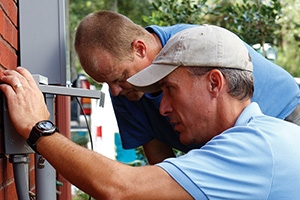
Actually, the biggest problem with using a generator isn’t whether it will work, how much the fuel will cost or whether you’ll have a source of fuel for the long term.
It’s how to hook that generator up to your home so that you can use the power it produces. Unless we’re talking whole house generators, they don’t come with a hookup for that, just a panel to plug into.
Many people’s answer to this is to make a short pigtail with male plugs at both ends. One end plugs into the generator’s power output panel and the other is plugged into the electrical outlet of your choice in the home.
While this might work if all you’re going to do is plug in one room air conditioner or the refrigerator, that’s a dangerous way to go. I highly recommend against it.
Here’s the problem. The wiring in most homes is 10 or 12 gauge. This wiring usually connects several outlets together, then goes off to the breaker box where it is connected to a 15 amp circuit breaker. That’s the most common size used in a home, with the exception of the garage, which will usually have a 20 amp breaker.
But a typical 3,500-watt portable generator can produce 29.17 amps of power, almost double the rating of that circuit breaker. A 5,000-watt portable generator, which is actually a better size for emergency power, produces 41.67 amps of power. That’s too much to go through the wiring.
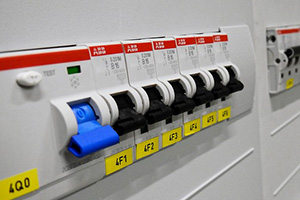 The purpose of circuit breakers is to protect the home from an electrical fire. If there is a short or too much electricity is run through a wire, it will overheat and can cause a fire.
The purpose of circuit breakers is to protect the home from an electrical fire. If there is a short or too much electricity is run through a wire, it will overheat and can cause a fire.
So, there are basically two option of what will happen if the jumper is used, running power into an outlet:
- If everything is connected to the same circuit, such as plugging it all into the same room, the wiring will overheat and cause an electrical fire.
- If everything is left connected all over the house, the circuit breaker for the circuit that the generator is plugged into will trip off, cutting power off to the rest of the house.
Another Important Connection Issue
Your home is connected to the electrical grid, through the breaker box and the power meter outside. If the grid is down and you’re producing electrical power that you’re running into your home’s electrical system, that electricity will run into the grid and disappear. You won’t get to use any of it.
Related: 11 Things You Need to Have Ready for when the Power Grid Fails
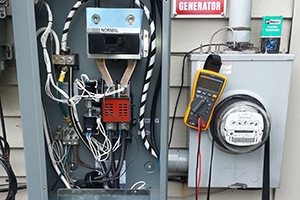 This problem is solved for whole-house generators by the installation of an automatic whole-house switch. This device monitors the electrical current flowing into your home.
This problem is solved for whole-house generators by the installation of an automatic whole-house switch. This device monitors the electrical current flowing into your home.
If the current stops, it disconnects your home from the grid and starts the generator automatically.
This ensures that all the electricity you are producing is available for your family’s use, rather than someone down the street.
When the power comes back on, the whole house switch reconnects the home to the grid, shutting off the generator.
A whole-house switch is a bit expensive. But there is a manual version as well, which can be purchased for much less. Better yet, some home breaker panels come with the main breaker, which performs this function for you. It’s a manual switch, but it does the job of disconnecting your home from the grid.
If either an automatic or manual whole house switch is used, it will provide a means of connecting the generator. But if you don’t want to spend that much money, there is a simpler answer, especially for homes that have a breaker box that includes a whole-house breaker up at the top.
The Breaker Interlock
In the case of homes with a main or master breaker in the breaker box, the easiest and least expensive means of making a safe connection for the generator is to use a breaker interlock. Put simply, this is a special circuit breaker, used just for this purpose.
It comes with a plate, which makes it impossible for the breaker interlock to be turned on unless the home’s main breaker is turned off. Materials for the whole installation should come to less than $150.
Before working on the breaker panel, be sure to shut all the breakers off, including the main breaker.
Then, once the cover is back in place, turn on the main breaker and all the others, one at a time, waiting about five seconds between each, to allow the initial surge to pass. Tripping them all on quickly, like some people do, is a good way to overload something in the system.
You’ll also want to turn off any solid-state electronic devices in the home, just like should be done during a power outage. There is often a surge when the power is turned back on, which can be damaging to electronic devices.
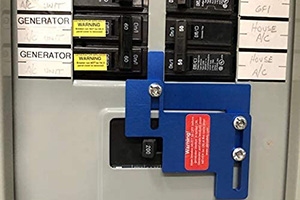
In order to install the breaker interlock, it may be necessary to move some of the existing breakers down the panel, freeing up the top two breaker locations on the right side of the panel.
This is the only location that the breaker can be installed in.
Most boxes have enough slack in the lines so that the existing breakers can be moved down two spaces, without causing problems.
Of course, the panel has to have those extra slots to put the breakers in. If it doesn’t the cost of the project will go up some, as one or two of the existing breakers will have to be replaced with double breakers to create the space needed.
The breaker interlock installs just like a normal breaker, but is wired differently. There are four wires involved:
- Red – Secondary Hot – goes to a terminal on the breaker interlock
- Black – Hot – goes to a terminal on the breaker interlock
- White – Neutral – goes to the neutral buss in the breaker box (look where all the other white wires are connected)
- Green – Ground – goes to the ground buss in the breaker box (look where all the other green wires are connected)
The other end of those wires needs to be run outside to a new box with either a 30 or 50 amp (round) connector for the generator to be connected to. These are larger than the standard 120-volt outlet which we have in our homes.
Those are only rated at 15 to 20 amps, so trying to run all the power from the generator through one of them creates the same fire risk we were talking about earlier.
Modify the Generator
Depending on the actual generator model you have, its power output and the way the outlet panel is wired, your generator may or may not have a 30 or 50 amp plug already installed in it.
However, there are a lot of generators out there (especially low-cost ones) which only have 20 amp, 120-volt outlets. If that’s the case on yours, the generator itself will need some modification.
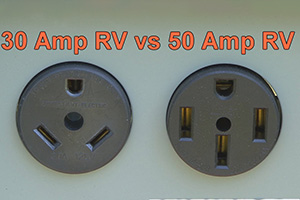 What’s needed here is to add the 30 or 50 amp connector, depending on the output of the generator. The highest power output which can be safely run through a 30 amp connector is from a 3500-watt generator. Anything rated higher than that will probably need a 50 amp connector.
What’s needed here is to add the 30 or 50 amp connector, depending on the output of the generator. The highest power output which can be safely run through a 30 amp connector is from a 3500-watt generator. Anything rated higher than that will probably need a 50 amp connector.
To install this on the generator find someplace near the existing outlets to mount a 2 gang metal electrical box. Open the existing connection panel and find the existing wires coming into it from the generator. Then add wiring from wherever these wires are connecting, to the connector in the new box.
Just remember that your total generator output doesn’t increase by adding another connector. If you’re pulling 30 amps out through this new connector, you probably won’t be able to use the other 120 volt outlets.
Related: Homemade Water Wheel Electric Generator
One last thing you’ll need is a short cable (15 ft. or so) to go from the generator to the outlet. You can make your own, buying the parts at your local building materials center or buy one that’s pre-made from an RV supply house. Just make sure it has the right connection on both ends.
Using the Generator During a Power Outage
Once you confirm that you have an actual power outage, you’ll probably need to dig the generator out of the shed or garage and park it outdoors, close to where the new outlet is. Then connect it, making sure the connectors seat all the way at both ends.
Check the generator’s gas tank and fill if necessary. Start the generator and ensure that it is running well at normal operating speed. Go indoors and turn off the main breaker, then turn off all the other breakers in the panel. Slide the protective interlock plate up and turn on the interlock breaker.
Finally, selectively turn on the breakers you need, for the critical electronics you need running. Wait about five seconds between each breaker, to allow the generator to adjust to the increased load.
Please note that a portable generator of the kind we’re talking about isn’t going to be able to run your home’s HVAC system, electric clothes dryer, or hot water heater. You might be able to run the stove and oven once the system is up and stabilized, but not if you’re using a lot of other high-energy users.
Anything with a heater of large motor is going to draw a lot of electricity. So you will need to carefully monitor and control what devices are being used. Electric heaters, clothes irons and appliances are all big energy users. While one might be able to be used at a time, that’s probably about it. More than that would overload the generator and probably cause the generator’s circuit breaker to trip.


No comments:
Post a Comment